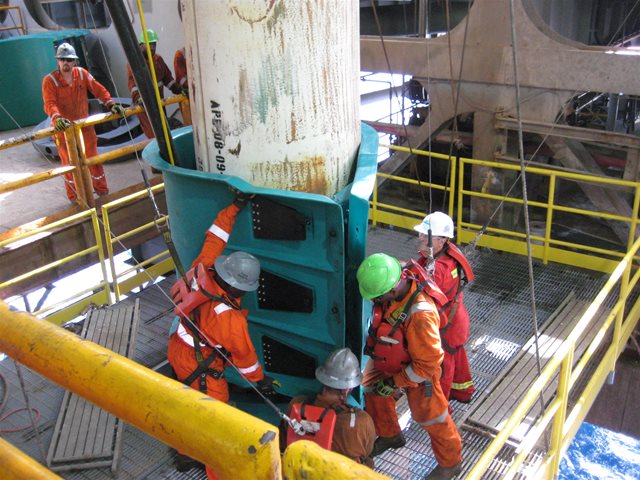Overview of Vortex-Induced Vibrations and Its Suppression Devices
Starts: Thu, Oct 11, 2018 11:30 AM CSTEnds: Thu, Oct 11, 2018 12:30 PM CST
Become a Member Now
 Vortex-induced vibration (VIV) is a precarious phenomenon caused by the flow of ocean currents past long slender tubulars such as production risers, steel catenary risers, drilling risers, tendons, pipelines, jumpers, and cables. Friction from a tubular’s surface causes boundary layers to form and shed from alternating sides of the tubular, producing oscillating forces and substantial vibration that can cause early fatigue failure. Fortunately, catastrophic failures of offshore structures can be avoided with proper planning and consideration of VIV mitigation techniques.
Vortex-induced vibration (VIV) is a precarious phenomenon caused by the flow of ocean currents past long slender tubulars such as production risers, steel catenary risers, drilling risers, tendons, pipelines, jumpers, and cables. Friction from a tubular’s surface causes boundary layers to form and shed from alternating sides of the tubular, producing oscillating forces and substantial vibration that can cause early fatigue failure. Fortunately, catastrophic failures of offshore structures can be avoided with proper planning and consideration of VIV mitigation techniques.
Helical strakes and fairings are the most popular devices installed on subsea tubulars to combat VIV. Helical strakes are fixed in place and break up the correlation of vortices. Fairings are free to rotate and streamline the flow so that only small vortices are shed at the fairing tail area, resulting in substantially lower drag and improved hydrodynamic damping. Fairings allow deepwater rigs to continue drilling in high currents when other operators may be shut down due to extreme top angles or wellhead fatigue concerns. When designed correctly, these suppression devices can reduce VIV by nearly 98% compared to a bare tubular.
This presentation will address various considerations related to the analysis, design, and installation of suppression devices.
Topics for discussion include:
Topics for discussion include:
• Comparison of suppression device geometries and their respective benefits/shortcomings
• SHEAR7 and other analysis programs to reduce conservatism and optimize suppression layouts
• Coverage length and density implications
• Effects of marine growth and ways to mitigate fouling
• Fairings versus alternative buoyancy concepts for deepwater drilling
• Offshore installation techniques
Attendees will gain a broader understanding of how to mitigate VIV and improve the long-term fatigue life of long slender tubulars exposed to strong ocean currents.
Who should attend this presentation
Individuals looking to learn more about improving the fatigue life of offshore structures (particularly long slender tubulars) exposed to high current loads: riser engineer, pipeline engineer, production engineer, SURF engineer, structural engineer, structural analyst, installation specialist, project manager, drilling supervisor, supply chain manager.
About the presenter
 Don Allen graduated from Texas A&M University with a B.S. in Mechanical Engineering in 1982 and completed his Ph.D. in Mechanical Engineering at Rice University in 1986. He joined Shell in 1987 and began work in offshore structures research with a focus on VIV suppression, which led to the discovery of the short fairing and tall helical strake. Don also led a joint industry program with MIT that resulted in the program SHEAR7 which has become the industry model for analyzing VIV of deepwater tubulars. Don managed the VIV suppression small business team within Shell and oversaw the successful manufacturing and installation of suppression devices for dozens of projects. In 2010, Don retired from Shell and founded VIV Solutions. Don holds 47 US patents and has also received several awards for his contributions to the offshore industry.
Don Allen graduated from Texas A&M University with a B.S. in Mechanical Engineering in 1982 and completed his Ph.D. in Mechanical Engineering at Rice University in 1986. He joined Shell in 1987 and began work in offshore structures research with a focus on VIV suppression, which led to the discovery of the short fairing and tall helical strake. Don also led a joint industry program with MIT that resulted in the program SHEAR7 which has become the industry model for analyzing VIV of deepwater tubulars. Don managed the VIV suppression small business team within Shell and oversaw the successful manufacturing and installation of suppression devices for dozens of projects. In 2010, Don retired from Shell and founded VIV Solutions. Don holds 47 US patents and has also received several awards for his contributions to the offshore industry.
About the presenter
 Don Allen graduated from Texas A&M University with a B.S. in Mechanical Engineering in 1982 and completed his Ph.D. in Mechanical Engineering at Rice University in 1986. He joined Shell in 1987 and began work in offshore structures research with a focus on VIV suppression, which led to the discovery of the short fairing and tall helical strake. Don also led a joint industry program with MIT that resulted in the program SHEAR7 which has become the industry model for analyzing VIV of deepwater tubulars. Don managed the VIV suppression small business team within Shell and oversaw the successful manufacturing and installation of suppression devices for dozens of projects. In 2010, Don retired from Shell and founded VIV Solutions. Don holds 47 US patents and has also received several awards for his contributions to the offshore industry.
Don Allen graduated from Texas A&M University with a B.S. in Mechanical Engineering in 1982 and completed his Ph.D. in Mechanical Engineering at Rice University in 1986. He joined Shell in 1987 and began work in offshore structures research with a focus on VIV suppression, which led to the discovery of the short fairing and tall helical strake. Don also led a joint industry program with MIT that resulted in the program SHEAR7 which has become the industry model for analyzing VIV of deepwater tubulars. Don managed the VIV suppression small business team within Shell and oversaw the successful manufacturing and installation of suppression devices for dozens of projects. In 2010, Don retired from Shell and founded VIV Solutions. Don holds 47 US patents and has also received several awards for his contributions to the offshore industry.
Donate to SUT
 Add this Event to your
Add this Event to your
Outlook Calendar

Houston, Texas 77079, USA
Phone: 281 591 4000
Website: https://www.technipfmc.com
Tickets
Webinar
Available Online Only
$35.00 Members Webinar
$40.00 Non-Members Webinar
FREE Student Members Webinar
$10.00 Student Non-Members Webinar
 Add this Event to your
Add this Event to yourOutlook Calendar
October 2018
Event Location

TechnipFMC
11740 Katy Freeway Energy Tower 3 Room: 2.02Houston, Texas 77079, USA
Phone: 281 591 4000
Website: https://www.technipfmc.com



